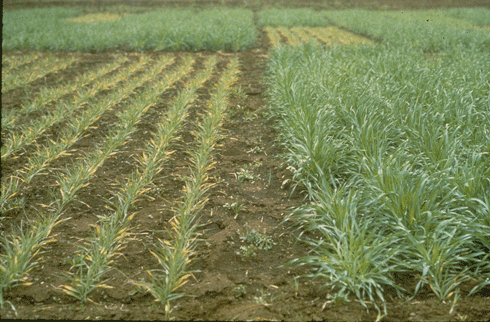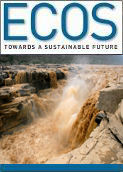
|
Published: 17 December 2012
Peak phosphorus and what we can do about it
Phosphorus equals life, but supplies of the world’s main source are fast-depleting. 2012 Environmental Research Eureka Prize winner, Dana Cordell, explains where the waste is occurring and what we can do to prevent phosphorus sources from running out.

|
|
Phosphorus-based fertiliser manufactured by chemical companies, such as France’s Compagnie Bordelaise, underpinned increased crop productivity during the 20th century. With the world now facing the prospect of a phosphorus shortage, experts say we must do more to recycle phosphorus and use it more efficiently and strategically. Credit:
estampemoderne.fr/flickr under CC BY-ND 2.0 licence
|
Not one to turn down a challenge, University of Technology, Sydney postdoctoral research fellow Dana Cordell, is the sort of person you’d want by your side in an emergency. As a result of her award-winning work, Cordell and the international research community are now beginning to respond to an emergency of global proportions: the dwindling state of the world’s main phosphorus supplies.
‘Phosphorus is an essential element, an essential building block for all life,’ says Cordell.
‘A world without phosphorus is like a world without oxygen, or carbon, or water – life wouldn’t exist as we know it.’
Cordell and her team at the Institute for Sustainable Futures (ISF), who won a 2012 Eureka Prize for their research, began looking into the global phosphorus situation back in 2005. One of their key pieces of work was an analysis to determine when, in a similar way to oil, the production of mined phosphate rock would peak.
Earlier estimates have indicated a phosphorus production peak sometime around 2033, but Cordell points out that new estimates of global phosphate reserves by industry mean that researchers need to continually update the ‘peak phosphorus’ horizon.
‘While those new studies indicate that there might potentially (but not conclusively) be more phosphate rock than previously thought in the ground, all that does is shift the peak phosphorus timeline by a few decades. It doesn’t change the underlying problem and doesn’t change the likelihood of peak phosphorus before the turn of the century, which is of great concern when you’re trying to feed 9 billion people,’ says Cordell.
Phosphorus is an element found in the earth’s crust and in all living things. It’s essential to plant growth and basic human functions – it’s in our cell walls and helps transport energy to the brain. Without it, animals can’t be fed, food can’t be produced and life on earth cannot survive.
Modern agriculture has played a significant role in the rapid depletion of the world’s main source of phosphorus – phosphate rock. The use of phosphate rock in chemical fertilisers has significantly boosted crop yields, but inefficient practices and a lack of foresight have led to an abundant waste of the precious element.
Squandered food is another key factor, particularly in affluent countries where food is plentiful and a lack of phosphorus recycling means more and more of it is winding up in our waterways, and causing pollution.
Despite the fundamental role phosphorus plays in all life on earth, and the rapid rates at which phosphate rock supplies are being depleted, there has been virtually no management of it by any national or international agency to ensure it’s available and accessible in the long term.
‘It’s been a bit of a sleeper issue and essentially fallen through the institutional cracks,’ says Cordell.
‘If you think about which government department or which industry might be responsible for ensuring long-term access to phosphorus, it’s not quite clear. There’s a real ambiguity of roles and responsibilities.’
In response, Cordell – and the Director of ISF Stuart White – have developed an international collective called the Global Phosphorus Research Initiative. Their aim is to mobilise international expertise on the sustainable use of phosphorus supplies for food security.
‘In launching this initiative, we really wanted to communicate these research findings and to engage the community, including policy and industry stakeholders, in discussing the dimensions of this global challenge,’ says Cordell.
‘This is something that affects everyone; it’s about our fundamental ability to grow food and to eat.’
While most people might turn away from such a seemingly insurmountable challenge, Cordell has embraced it as an opportunity for action. ‘The good news is there’s a lot we can do.
‘There is no one solution, so we’ll need to take an integrated approach. First, we need to look at recovering phosphorus from all organic sources via recycling processes. This includes our own excrement—urine and faeces—in addition to food waste, crop waste, manure and possibly even algae and other new sources.
‘The other really important thing we need to do is use phosphorus much more efficiently, such as in the way we source it, and how we use it during fertiliser production – phosphorus is lost along the way from mine to field through leaks and spillages and perhaps old technologies and management processes that could be updated.’
Cordell points to agricultural practices as an opportunity for using phosphorus more efficiently.
‘Applying it at the right time, applying it where the plant roots are actually going to use it, and improving soil quality will result in more phosphorus that’s locked up in soils becoming available in a soluble form to plant roots.
‘Equally, downstream from agriculture, we should be thinking about efficiency measures in the food production and processing chain.
‘What we need now are effective policy instruments to facilitate these technologies and practices to use and recycle phosphorus more sustainably.’
However, the fact remains phosphate rock is a finite resource. To make best use of our reserves, countries around the world will have to commit to monumental changes. Australia, which is the fifth largest consumer of phosphate fertiliser in the world, will too.
‘Australia is in a very unique situation,’ says Cordell. ‘While we have naturally phosphorus-deficient soils, the food we grow and export feeds around 60 to 70 million people – mostly in the Asia Pacific region. What that means is we need a lot of phosphorus. Even if we recycle 100 per cent of it, it would nowhere near meet our demand.
‘We might need to rethink the profiles of our agriculture and export industries in the future, which is not an easy thing to do.’
Despite the magnitude of the problem, however, the ever-upbeat Cordell still sees a light at the end of the tunnel.
‘I don’t think it’s going to be easy, but I do think it’s possible. The first step is to ensure we keep the dialogue open with policy makers, industry, researchers and the community.’

|
|
2012 Environmental Research Eureka Prize winner, Dana Cordell Credit:
Joanne Saad
|
Dr Dana Cordell is a postdoctoral research fellow and research principal at the Institute for Sustainable Futures at UTS. She co-founded the Global Phosphorus Research Initiative (GPRI) and public website phosphorusfutures.net in 2008 with colleagues in Sweden and Australia. The GPRI has since expanded to represent six leading research institutes across Europe, Australia and North America. This article first appeared in the University of Technology, Sydney’s U: magazine and has been republished with permission.




